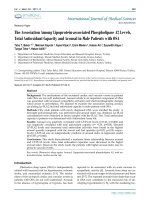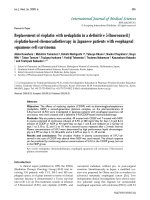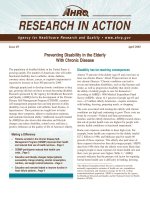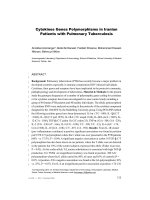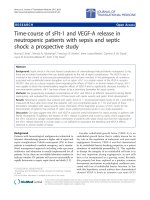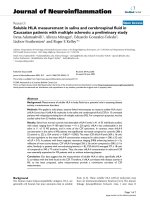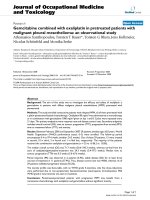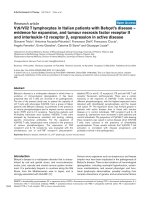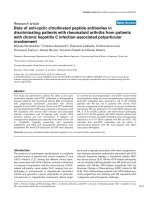Novel ATP7B mutations in vietnamese patients with wilson disease
Bạn đang xem bản rút gọn của tài liệu. Xem và tải ngay bản đầy đủ của tài liệu tại đây (443 KB, 6 trang )
Novel ATP7B mutations in Vietnamese patients with Wilson disease
Tue T. Nguyen, Tuan L.A. Pham, Tu C. Ho, Dat Q. Tran, Thinh H. Tran, Van T. Ta, and Khanh V. Tran
Center for Gene-Protein Research, Hanoi Medical University, Hanoi, Vietnam
Abstract
Wilson disease (WD) is an autosomal recessive disorder of copper metabolism. It is caused by defects
of ATP7B encoding a copper transporting P-type ATPase. The gene is located on chromosome
13q14.3. Mutation of this gene disrupts copper homeostasis, resulting in the accumulation of copper
in the liver, brain, kidneys and corneas and copper toxication at these sites. Until today, more than
300 disease-specific mutations have been identified. To detect mutations of the entire ATP7B gene in
Vietnamese patients with WD, sequencing analysis was applied. We detected three mutations in
ATP7B genes that have not previously been reported. Two are missense mutations and one is a nonsense mutation. Furthermore, segregation analysis showed no mutation transmission patterns within
each family of WD patients. Novel mutations in ATP7B in Vietnamese WD patients merit inclusion
into the genetic epidemiology and the population genetic public database.
Publicaton Date (Web): February 29, 2016
Full-text Download: PDF
DOI: dx.doi.org/10.20328/vjsonline.2016.rr1
Editor: Thu V. Vuong, University of Toronto, Toronto, Canada
1. Introduction
Copper is an essential component of many enzymes such as: lysyl oxidase, superoxide dismutase,
dopamine-β-hydroxylase and cytochrome C oxidase. These copper-dependent enzymes are needed
for diverse process of oxidase metabolism including respiration, free-radical detoxification,
neurotransmitter synthesis, maturation of connective tissue and iron uptake (1-2). However, copper
is only required in trace amounts; accumulation of copper can damage plasma membranes,
peroxisomes, mitochondria, microtubules, enzymes and even DNA (3). The effect of copper
imbalance can be described best in two human genetic disorders: Wilson’s Disease (WD) and
Menkes’s Disease. WD is an inherited autosomal recessive disease first described in 1912 by Samuel
Alexander Kinnier Wilson. Prevalence of the disease is approximately 1 in 30,000. In 1993, Bull et al.
identified the genetic defect of WD within the copper-transporting P type ATP7B gene located in
chromosome 13 (4). According to Wilson’s Disease Mutation Database (http://
www.wilsondisease.med.ualberta.ca/database.asp), more than 300 disease-causing mutations have
been detected and the number is still growing because mutations in the ATP7B gene vary in different
populations. A recent study identified a mutation hotspot in exon 2, 8, and 10 within a sample of
Northern Vietnamese population (the data have been submitted for publication). In this study we
have identified three novel mutations in ATP7B with WD by using DNA sequencing. All of them are
heterogeneity mutation.
2. Materials and methods
2.1. Subjects and DNA extraction
Three Vietnamese patients from unrelated families were selected. All patients had been diagnosed
with WD and treated at the National Hospital of Pediatrics in Hanoi, Vietnam. WD diagnosis was
based on multiple clinical symptoms, including liver failure and/or neurological issues and/or the
presence of Kayser- Fleischer ring in eyes, and biochemical markers, such as low serum ceruloplasmin
(CP <20 mg/dL) and high level of urinary copper (Cu >100 mg/24h) (5). Genomic DNA was extracted
from peripheral blood collected in EDTA tube using Wizard Genomic DNA Purification Kit (Promega,
Madison, Wisconsin, USA) following manufacturer’s protocols.
2.2. Polymerase Chain Reaction (PCR)
Entire exons of ATP7B gene were successfully amplified by using 24 primer pairs (four primer pairs for
exon 2, one primer pair each for others) (IDT, Coralville, Iowa, USA). PCR was performed using GoTaq
Green Master Mix (Promega, Madison, Wisconsin, USA) with 100 ng of genomic DNA in a mix
containing 1U of Taq Polymerase, 10 pmol of each primer and distilled water. The thermocycle
program consisted of an initial denaturation at 95 ºC for 5 min, followed by 35 cycles at 95 ºC for 30
s, 55 ºC for 45 s, and 72 ºC for 30 s, with a final extension at 72 ºC for 3 min. The size and quantity of
PCR products were verified by electrophoresis in 1.5 % agarose gel.
2.3. DNA sequencing
PCR products were directly sequenced using BigDye Terminal Kit (Amersham, UK) and Avant 3100
Genetic Analyzer automated sequencer (Applied Biosystems Inc., Foster City, California, USA), and
data was analyzed using CLC Genomics Workbench (CLC Bio, Qiagen, Venlo, Limburg, Germany). All
products were sequenced in both forward and reverse strands.
3. Results
All three patients demonstrated similar symptoms and laboratory analyses revealed low
ceruloplasmin, low serum copper and increased urinary copper excretion (Table 1). Genomic DNA
was isolated from the peripheral blood leukocytes of the subjects. DNA sequencing analysis was
applied to identify mutations and polymorphisms of all 21 exons of ATP7B gene in 3 Vietnamese
patients with WD. One nonsense mutation and two missense mutations in Table 2 were found to be
novel: c.3233C>G; c.2943T>G; c.2705T>C (Figure 1). This procedure used Polyphen, an automatic tool
predicting possible impact of amino acids substitution on the structure and function of human
protein in analyzing the novel missenses mutation. The mutations were correctly identified as novel
mutations in the WND database (http:// www.wilsondisease.med.ualberta.ca/database.asp).
Table 1: ATP7B genotype, clinical and laboratory findings
Affected organ
Mutation
Patient
c.2705T>C
Liver
Brain
WD 52
-
+
c.2943T>G
WD 27
+
-
c.3233C>G
WD 23
+
-
Laboratory finding
Serum CP
(mg/dL)
Urine Cu
(μg/day)
6.0
325
+
<10
220
+
<10
180
KF-ring
Notes: Genbank Accession NM_000053. The first nucleotide of ATG translation codon is considered
nt + 1. Serum CP was measured by Immnoturbidmetric test. Normal values for serum CP is 20-60
mg/dL (5). Normal values for urine Cu is 10-40 μg/day (5).
Table 2: Mutations distributed throughout the entire coding region of ATP7B
Nucleotide change
Exon/intron
Codon change
Mutation
Type
c.2705T>C
11
L902P
novel
missense
c.2943T>G
13
I981S
novel
missense
c.3233C>G
14
Y1078X
novel
nonesense
Notes: Genbank Accession NM_000053. The first nucleotide of ATG translation codon is considered
nt +1.
Clinical manifestation of three patients showed involvements of three affected organs including liver,
brain, and cornea with low level of serum ceruloplasmin (Table 1). Segregation analysis within 3
families (including parents and one brother) was performed for 3 patients whose mutations in
the ATP7B gene had been detected, but no mutations were identified.
Figure 1. Sequencing results of three novel mutations on ATP7B gene of Wilson’s disease patients
4. Discussion
Wilson disease is an infrequent disorder worldwide in almost all populations. Frequencies of
1:30,000 to 1:40,000 are usually quoted (6), except for Crete and Sardinia with 6:100 and 1:7,000 live
births respectively (7-8). At present, diagnosis of WD is extremely difficult especially for clinically
asymptomatic individuals or those with atypical clinical manifestations. Moreover, different WD
patients have different clinical features (9). Particularly, WD is representative of a low number of
diseases that difficult to be treated; however, early diagnosis increases the probability of recovery
(9).
Until now, more than 300 mutations have been reported in many different populations but a few of
them show relative high frequencies in some geographic areas. The most frequent mutation in
Europe is H1069Q with values over 65 % (10), in Sardinia, c.-441_- 427del accounts for 61.5 % of
mutated chromosomes (8), mutation M645R is present in 55 % of patients in Spain (11), and R778L is
very frequent in Hong Kong patients (12). Deletion c.3402delC at exon 15 has been reported
worldwide at low frequency (usually below 2 %) in several populations; contrarily a high frequency
(34.8 %) occurs among Brazilian index cases (13) and the most frequent mutation in Vietnam is
S105X with 21.05 % (data submitted for publication).
In recent years, assisted by the development of molecular analysis, the diagnostic rate has been
improved. However, clinical laboratory molecular diagnosis is expensive because there are many
types of ATP7B gene mutations. Novel mutations appearing in some populations or races are
inevitable; therefore, wide publication of these novel mutations and screening to identify some
mutation hotspots are essential.
5. Conclusion
In our study, three novel mutations (c.3233C>G; c.2943T>G; c.2862A>G) in the ATP7B gene were
detected in 3 WD patients by sequencing all exons. Our data enrich the database of Vietnamese WD
as well as the WND database.
Acknowledgment
This research is funded by Vietnam National Foundation for Science and Technology Development
(NAFOSTED) under grant number 106.16-2011.01.
About the authors
Dr. Tue T. Nguyen received PhD from Kyoto Institute of Technology at Kyoto, Japan in 2011; his
researches focus on human genetic disease using the Drosophila melanogaster model. Tuan L.A.
Pham, Tu C. Ho, Dat Q. Tran are researchers at the Center for Gene-Protein Research at Hanoi
Medical University. Dr. Thinh H. Tran got PhD from Kyoto University in 2011 and his study is
immunology or related fields. Prof. Van T. Ta is a vice rector of Hanoi Medical University and head of
the Center for Gene-Protein Research. Assoc. Prof. Khanh V. Tran is an expert on the DMD; she has
many experiences in human genetic diseases.
References
1. Yuan, D. S., Stearman, R., Dancis, A. et al (1995). The Menkes/Wilson disease gene homologue in
yeast provides copper to a ceruloplasmin-like oxidase required for iron uptake. Proc Natl Acad Sci U S
A, 92 (7): 2632-2636.
2. Linder, M. C. and Hazegh-Azam, M. (1996). Copper biochemistry and molecular biology. Am J Clin
Nutr, 63 (5):797S-811S.
3. Duc, H. H., Hefter, H., Stremmel, W. et al (1998). His1069Gln and six novel Wilson disease
mutations: analysis of relevance for early diagnosis and phenotype. Eur J Hum Genet, 6 (6): 616-623
(View Article).
4. Bull PC, T. G., Rommens JM, Forbes JR, Cox DW (1993). The Wilson disease gene is a putative
copper transporting P-type ATPase similar to the Menkes gene. Nat Genet, 5: 327–337.
5. Roberts, E. A., Schilsky, M. L. and American Association for Study of Liver, D. (2008). Diagnosis and
treatment of Wilson disease: an update. Hepatology, 47 (6): 2089-2111 (View Article).
6. Pfeiffer, R. F. (2007). Wilson’s disease. Semin Neurol, 27(2):123-32.
7. Dedoussis, G. V., Genschel, J., Sialvera, T. E. et al (2005). Wilson disease: high prevalence in a
mountainous area of Crete. Ann Hum Genet, 69 (Pt 3): 268-274 (View Article).
8. Loudianos, G., Dessi, V., Lovicu, M. et al (1999). Molecular characterization of wilson disease in the
Sardinian population--evidence of a founder effect. Hum Mutat, 14 (4): 294-303 (View Article).
9. Liu, Y., Zhou, H., Guo, H. et al (2015). Genetic and Clinical Analysis in a Cohort of Patients with
Wilson's Disease in Southwestern China. Arch Med Res, 46(2):164-9 (View Article).
10. Vrabelova, S., Letocha, O., Borsky, M. et al (2005). Mutation analysis of the ATP7B gene and
genotype/phenotype correlation in 227 patients with Wilson disease. Mol Genet Metab, 86 (1-2):
277-285 (View Article).
11. Margarit, E., Bach, V., Gomez, D. et al (2005). Mutation analysis of Wilson disease in the Spanish
population -- identification of a prevalent substitution and eight novel mutations in the ATP7B
gene. Clin Genet, 68 (1): 61-68 (View Article).
12. Mak, C. M., Lam, C. W., Tam, S. et al (2008). Mutational analysis of 65 Wilson disease patients in
Hong Kong Chinese: identification of 17 novel mutations and its genetic heterogeneity. J Hum
Genet, 53 (1): 55-63 (View Article).
13. Deguti, M. M., Genschel, J., Cancado, E. L. et al (2004). Wilson disease: novel mutations in the
ATP7B gene and clinical correlation in Brazilian patients. Hum Mutat, 23 (4): 398 (View Article).
Discussion and Closure of "Novel ATP7B mutations in Vietnamese patients with Wilson disease" by
Tue T. Nguyen et al.
